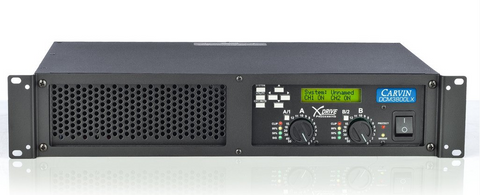-
Audio
-
Guitar
-
Bass
-
Blog
-
SALE
- Financing
- Support
- SINCE 1946
March 10, 2023
February 17, 2023
October 07, 2021
For some, which gear to power up first is common sense. Others couldn’t be bothered to pay attention to such trivial details. Some may know which gear to power up first but not why, and for some, this may be the first you’ve heard of this question.
Whatever the case, we’ll go over the proper power up sequence here and explain why it’s important.
March 21, 2017
50 years ago The Beatles performed at Shea Stadium to a crowd response so enthusiastic that you couldn't hear the band. From the moment that Ed Sullivan introduced the band, rock music history was changed forever. It was August 15, 1965 and Beatlemania had definitely infected the US rock audience, spawning the famous scenes of them running away from crowds of screaming girls.
June 17, 2016

One of the biggest choices musicians and pro audio enthusiasts make when purchasing speakers is whether they should spring for passive or active speakers. Just like with any equipment, the right choice comes from a combination of understanding the main components of each and finding the one that best suits your application. This basic guide will cover the main differences between active and passive models and help you choose which one is better for your needs.
June 07, 2016

Power ratings can be one of the more confusing concepts, especially for newer players looking to find the perfect match of head and cab or to get a PA system up and running. Unlike power amplifiers and bass amp heads, which generally list a single rating or ratings at different impedances, speakers have up to three ratings listed, further confusing matters! But fret not- this article will break down the differences between these numbers and what they all mean.
How Power Handling is Determined
Speaker power handling is a very complex subject. But you need to understand the general ideas behind these ratings to prevent breaking your gear! For a practical, real world example, let’s take a look at the ratings of the Carvin Audio PM12.
Carvin Audio PM12: 300W continuous, 600W program, 1200W peak.
For most companies, these are real tested numbers, but they are not the same tests used in power amp or instrument amplifier testing. The power handling of a speaker is determined by the temperature rise of the speaker’s voice coil over a period of time. The unique thing is the input signal used to test the speaker. Because speakers use small wire to make up the voice coil, they do not hold up very well to the sine wave or single tone signals used in power amp testing. For speaker testing, the input signal is pink noise, which are essentially random sine wave tones of all the audio frequencies with the same energy level per octave.
You may be more familiar with white noise, which it is all frequencies with the same level regardless of octaves. To experience some white noise, turn up your guitar amp full or your mixer mic preamp. It’s that “Shhhhh” sound. If you turned down the presence or treble knob a little that would start to sound like pink noise. Pink noise sounds like it has more low frequency or bass content, and that’s the per octave part.
The pink noise signal for speakers has one more special ingredient, and that is how its peaks are limited which is called the crest factor. The crest factor corresponds to how high the peaks are above the average level. The average level is measured by an RMS voltage meter and this is called the continuous level. The crest factor is typically 6dB, which means the peaks in the pink noise are twice the voltage level of the continuous RMS measurement. So you say “twice, but the peak wattage is four times.” If we look at the resulting wattage on the speaker the equation is:
Speaker power = the square of the voltage / the impedance of the speaker or P=V2 / R
If you double the voltage at the peaks, it creates four times the wattage, because the voltage is squared. The program level is just a reference where the wattage has doubled and is not really a testing parameter.
If this sounds complicated, don’t worry- what you need to know is how these ratings apply to your day to day life using your gear.
What the Numbers Mean to You:
The continuous rating is the base line wattage that the cabinet can handle without risking any harm to the voice coil or other parts of the speaker. This is considering extended periods of use, like at a gig or rehearsal. If you have a 300 watt PM12, it can handle a 300W amplifier’s output. But remember never to clip your amplifier, because the clipping output of your amplifier is like putting four times the amp’s rating of RMS power into your speaker. The speaker can handle peaks of four times, but these are short clean audio peaks, not the continuous output of clipping. Clipping usually steals life from your speakers and the clipping signals really don’t make much sound, slamming the speaker all the way in or out. If the speaker is not moving it’s not making any sound, but the coil will still burn.
Time to demystify a myth here: “Under powering a speaker.” The continuous rating is not the minimum wattage you can put into your speaker. Using amplifiers that are under the continuous rating will not harm your speaker. Under powering a speaker will not bring the speaker to full output. On the other hand, you can under power a show by bringing too small a system for the show and running it into clipping. A speaker can handle some clipping but the amplifier’s rated wattage would have to be four times less than the speaker’s continuous rating to be safe for clipping. That’s a small amplifier at about 75 Watts for the PM12.
The program rating is the maximum wattage that the speaker can handle in bursts. This is usually the better amplifier wattage to shoot for when matching an amp to a speaker. The PM12 has a program ratting of 600W. If you use a 600W amplifier you have 3dB more of clean headroom before approaching clipping. Also, amplifiers are limited in their power supplies and usually only produce about twice more output on peaks, so this could produce the full 1200W peaks. Or at least that is in theory. This would then produce the full output of the speaker or Max SPL.
The peak rating is the maximum wattage the voice coils can take in very short peaks. As mentioned before, this is used if you are trying to achieve the maximum output of the speaker or Max SPL rating.
So, Which One Should You Go By?
A speaker’s continuous and program ratings are the most relevant to most musicians and pro audio enthusiasts. The peak rating details the upper limits of the speaker’s power handling capacity and max SPL. A good way to remember this is to think of your speaker like your vehicle. When driving your vehicle, you’ll be driving between 20-80 mph most of the time. This is like your speaker’s continuous to program rating- it is the common, day to day usage. The peak rating is akin to the top of your car’s speedometer. Yes, your car can go 120mph (don’t try it, you’ll get a ticket!) but it won’t be able to sustain that for very long without the risk of mechanical or thermal damage.
Question in Scott's comment:
February 09, 2016
Did you know the HD series amplifiers have a 100Hz low pass crossover built in? This is great for adding subwoofers to your system. In many simple cases with full range top cabinets, you don't really need to crossover mains to the subwoofers.
November 24, 2015

If you are in the market for amplifiers, you have two broad categories to choose from: professional amplifiers or home (consumer) amplifiers. Before you can select which amp is best for you, you need to analyze your needs and preferences. To paint the situation with a broad stroke, we can say pro amps are generally great for sound reinforcement (they project sound over an extensive area), come with a lot more features and are durable. However, let’s take a closer look at the pros and cons of each type:
September 23, 2015

In the days of hardware based electronic crossovers, it was necessary to send your bi-amp signals to separate power amps and then connect to your speaker's high frequency and low frequency drivers with separate cables or a custom wired cable. This made for a larger truck pack having more cables per speaker and a greater number of connection points between the board, crossover, power amps and speakers.
May 05, 2014
Sign up to get the latest on sales, new releases and more…
NoFraud Frequently Asked Questions
"Make a joyful noise unto the Lord all of the earth; make a loud noise and rejoice and sing praises. Sing to the Lord with the harp and the voice of the psalm." - Psalm 98:4-5
© 2025 Carvin Audio.
Carvin Corp.
POS and Ecommerce by Shopify

I’m pondering a passive speaker with Full Range Power @ 8 ohms of 600w Continuous /1200w Program /2400w Peak.
I’m also looking at an amp with the following specs:
OUTPUT POWER
1 CHANNEL RMS continuous
- 8 ohms: 400 watts
- 4 ohms: 700 watts
- 2 ohms: 1150 watts
BOTH CH RMS continuous
- 8 ohms: 325/325 watts
- 4 ohms: 600/600 watts
- 2 ohms: 1000/1000 watts
BRIDGED RMS continuous
- 8 ohms bridged: 1200 watts
- 4 ohms bridged: 2000 watts
I have no idea which set of amp numbers to look at (1 ch, both channels, or bridged?) Would this amp be a good fit for this speaker? (I’d like the amp to power two of these speakers.)
Thanks for any input you can give me.
Answer:
Here is how I would approach this. First you are starting with the cabinet. This is fine, because you need to start somewhere, and the speaker is probably better. Your choice of cabinet has a continuous wattage of 600 watts and it is 8 ohm. You also mentioned you would like to run two cabinets.
Of course any wattage amp will run the cabinet, but here we are trying to maximize the output of our system. If you could only afford a 200 watt amp, just don't try to do a show that should have 1200 watts. A 200W amp clipping will burn a 600W cabinet eventually.
Back to the point, the ideal setup is where the amp's RMS rating is around the speaker's program rating. This lets the amp's peak wattage approach the peak wattage of the cabinet. In this case two 1200 watt cabinets at 8 ohm each would be like a single cabinet at 2400 watts at 4 ohms. With the amp you listed doing 2000 watts bridged in a 4 ohm load, you are very close to ideal. This amplifier would perform well with these cabinets. One thing this does account for is AC line sag. If you can afford to bump the amp to a 3000 watt amp at 4 ohms you will have another 1.5DB of headroom for poor AC sag. This is often another reason for amplifiers clipping early. If you don't supply solid AC the amplifier can't put out its rated wattage. For PA subwoofers and mains it is best to get as much dynamic headroom as you can in the amplifiers. It's a lot more fun to run a big rig easy than slamming a small rig to its limits.
Hope this helps.